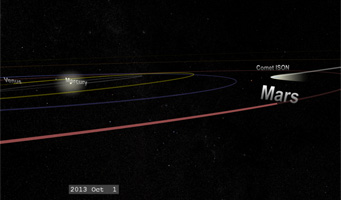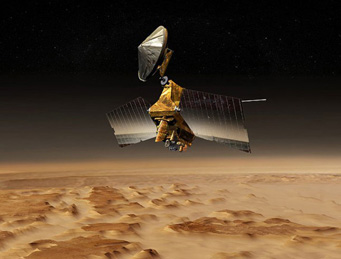On October 1st, Comet ISON will pass closer to Mars than it ever will to Earth. The Red Planet’s rovers and orbiters are ready to send home postcards of the event.

NASA's new animation shows Comet ISON's path through the inner solar system.
NASA's Goddard Space Flight Center Scientific Visualization Studio
In one week the (in)famous Comet ISON will make its closest approach to Mars, flying just 10.8 million km (6.7 million miles) from its surface on October 1st. All Martian eyes will be watching, including Curiosity’s, though a postcard-perfect picture is far from guaranteed.
Curiosity and Opportunity will both be watching as ISON passes overhead, but the most likely detection will come from the HiRISE camera aboard NASA’s Mars Reconnaissance Orbiter. That camera resolves 1-meter (3-foot) features on the Martian surface, but the unprecedented sharpness of its daylit landscapes doesn’t necessarily mean it will do well on a dim glow in darkest space several million km away. NASA already planned a test observation for August 20th, and unfortunately (but not unexpectedly), Comet ISON remained just below the detection threshold.
“For missions like MRO that are designed to look at a planet around which they are orbiting, turning their instruments in the opposite direction and trying to detect a fuzzy iceball is not something that’s done on a whim,” writes Karl Battams on the Comet ISON Observing Campaign blog. “It has to be meticulously planned, prepared for, and tested.”

The Mars Reconnaissance Orbiter, sailing some 15,000 miles above the Red Planet's surface, will attempt to capture Comet ISON's close passage.
NASA / JPL
MRO is also planning to look during another three observing windows: on September 29th, and October 1st and 2nd. Mars Express was scheduled to start looking yesterday (September 23rd), and the Swift spacecraft’s Ultraviolet/Optical Telescope will take observations on October 1st. For the full list of planned professional observations of Comet ISON, see CIOC’s Observation Calendar.
Regardless of how the observations of Comet ISON turn out next Monday, they promise to be good practice for Comet Siding Spring, which will come 216 times closer (within 110,000 km of the Red Planet) in October 2014.
By the Numbers
The Mars flyby is the first of several close encounters:
- Oct. 1st: Comet ISON sails 10.8 million km from the Martian surface
- Nov. 19th: ISON will pass closest to Mercury, with Messenger as its witness.
- Nov. 28th: Comet ISON whips through the outer solar corona, passing within 1.2 million km of the Sun’s visible surface.
- Dec. 26th: Assuming the comet survives its graze past the Sun, it’ll pass 64.2 million km from Earth (167 times farther than the Moon).
Watch this animation from NASA's Goddard Space Flight Center Scientific Visualization Studio to see two views of the comet’s trajectory through the inner solar system:
Or play with this interactive model of Comet ISON's orbit from visualization company INOVE.
 9
9
Comments
Kevin Heider
September 24, 2013 at 10:28 am
C/2013 A1 (Siding Spring) is expected to pass 0.00089 AU (133,000 km; 83,000 mi) from the center-point of Mars.
You must be logged in to post a comment.
Monica Young
September 24, 2013 at 10:48 am
Thanks for the catch, Kevin, I've corrected the article, which previously stated that Comet Siding Spring would come within 50,000 km of the Red Planet. That was based on the March 2012 estimates, but later estimates in April put the comet's orbit farther out: http://www.jpl.nasa.gov/news/news.php?release=2013-081.
You must be logged in to post a comment.
John Sheff
September 24, 2013 at 3:52 pm
What's the comet's flyby distance from Mercury?
You must be logged in to post a comment.
Kevin Heider
September 24, 2013 at 4:59 pm
ISON's closest approach to Mercury is 2013-Nov-19 at a distance of 0.24207 AU (36,213,000 km; 22,502,000 mi).
From the surface of Mercury ISON would be 107 degrees from the Sun in the constellation of Orion.
You must be logged in to post a comment.
Kevin Heider
September 24, 2013 at 5:03 pm
Monica,
You can get the latest close-approach data for the comet Siding Spring at Mars encounter using the following JPL SBDB link:
http://ssd.jpl.nasa.gov/sbdb.cgi?sstr=2013A1;cad=1#cad
It includes the min distance, max distance and nominal solution. It is a 3-sigma solution.
You must be logged in to post a comment.
Mike Martin
September 24, 2013 at 6:49 pm
I've been watching ISON for about a couple of months now And it seems to be in Cancer quite a bit. Any reasoning in back of this. Clear Sies. Mike
You must be logged in to post a comment.
Kevin Heider
September 25, 2013 at 7:52 am
ISON is still 2.3AU (2.3 times further from Earth than Earth is from the Sun), so apparent movement against the background sky will be slow. From 2013-Apr-27 to 2013-Aug-02 ISON was in Gemini. From 2013-Aug-03 to 2013-Sep-24 it is in Cancer. As of 2013-Sep-25 ISON is entering Leo.
You must be logged in to post a comment.
Anthony Barreiro
September 27, 2013 at 5:30 pm
@ Mike Martin -- where are you and what are you using to observe Comet ISON? What does it look like? As soon as the Moon wanes I'm going to give it a try.
You must be logged in to post a comment.
Bill
October 1, 2013 at 9:29 am
Will all observations of ISON from Mars be lost due to the government shutdown, or were they able to program the probes ahead of time? All NASA websites seem to be down.
You must be logged in to post a comment.
You must be logged in to post a comment.